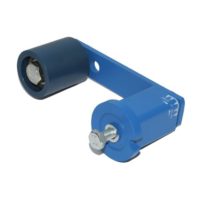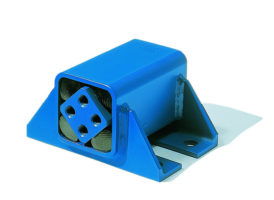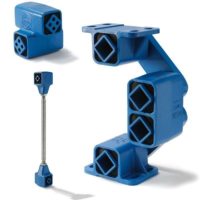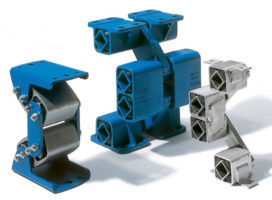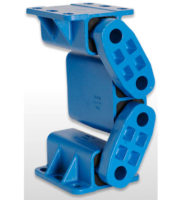
2.9
Oscillating Mountings
90°
±
1°
Technology
Determination of the average material conveying speed v
m
Main influencing factors:
–
Conveying ability of the
material
– Height of the bulk goods
– Screen box inclination
–
Position of unbalanced motors
–
Position of the center of gravity
The material speed on circular
motion screens does vary, due
to differing screen-box inclina-
tion angles.
•
Example:
The horizontal line out of the
intercept point of stroke
(7.7 mm) and motor revolutions
(960 rpm) is indicating an
average theoretical speed of
12.3 m/min or 20.5 cm/sec.
Alignment of the elements
If the suspensions for linear motion screens are arranged as
shown on page 2.7, a harmonic, noiseless oscillation of the
screen will result. The rocker arm fixed to the screen carries
out the greater part of the oscillations. The rocker arm fixed
to the substructure remains virtually stationary and ensures a
low natural frequency, and thereby also a good vibration
isolation. The mounting axis has to be arranged to be at
right angles
(90°) to the conveying axis, with maximum
tolerance of ±1°.
Resonance amplification and
continuous running
At the screen start-up and run-out the suspension elements
are passing through the resonance frequency. By the result-
ing amplitude superelevation the four rubber suspensions in
the AB mountings do generate a high level of damping
which is absorbing the remaining energy after only a few
strokes. The screen box stops its motion within seconds.
Laboratory measurements of a typical development of the
residual forces on a ROSTA screen suspension:
Screen box fixation
Substructure
cm/s
m/min
53
32
50
30
47
28
43
26
40
24
37
22
33
20
30
18
27
16
23
14
20
12
17
10
13
8
10
6
7
4
3
2
1
2
3
4
5
6
7
8
9
10
11
12
13
14
15
16
17
18
19
20
21
22
9 g
8 g
7 g
6 g
5 g
4 g
3 g
2 g
n
s
= 720
n
s
= 960
n
s
= 1440
n
s
= 2880
Oscillating stroke sw [mm]
物料输送速度v
m
Diagram for angle of inclination
β
= 45°
to the horizontal
start-up
continuous running
run-out
vertical force
time
Oscillation
direction



